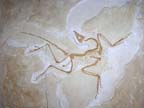 |
 |
 |
 |
 |
Produced
by the Population Genetics and Evolution class, Furman University |
||||
 |
 |
 |
 |
 |
Produced
by the Population Genetics and Evolution class, Furman University |
||||
 |
The
Paleogene: Mesonychids |
 |
||
| Mesonychids
were a group of predatory ungulates (Hall 2005), and their fossils have
been found in Western America and Canada, as well as in Northern Mongolia
and China (Ponzetti 2006). Their most characteristic feature was that
they had primitive hooves. These early hooves were a mix between very
long toenails and hooves, and each toe of this four-legged creature had
one hoof (Hall 2005). Mesonychids exemplified a wide variety of appearances,
ranging from those similar to wolves, hyenas, bears, and dogs (Jehle 2010).
However, even though they are similar in appearance to land animals, some
consider Mesonychids to be ancestors of whales. They had an elongated
skull and triangular teeth, which are similar to whales. These creatures
also had an inner ear, which is a characteristic feature of whales (Nelson
2010). Although many ungulates are herbivores, Mesonychids were predatory
carnivores. They may have also been scavengers, similar to hyenas. They
had powerful jaws, and their teeth, as previously mentioned, were similar
to whales’ teeth. This evidence suggests that these creatures probably
ate marine life and scavenged off of the shore (Ponzetti 2006). However,
they probably used their primitive hooves to hold the meat in place, while
they tore it off using their teeth (Jehle 2010). Page by Lindsey Gerzel |
 |
| Mesonychids.Picture From: The Cryptid Zoo
| |
|
Hall J. 2005. The Cryptid Zoo: Mesonychids in Cryptozoology. Accessed April 12, 2010. Jehle M. 2010. Carnivores, creodonts, and carnivorous ungulates: mammals become predators. Paleocene Mammals of the World. Accessed April 12, 2010. Nelson LA. 2010. The evolution of whales. Cetacean Evolution. Accessed April 12, 2010. Ponzetti TM. 2006. What are Mesonychids? Blue Lion. Accessed April 12, 2010. |